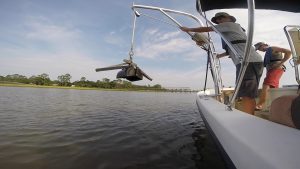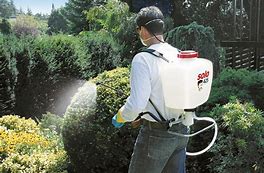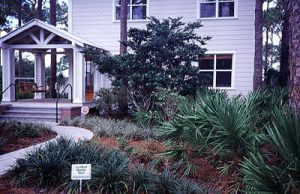In the mid 1990’s, the Bay Area Resource Council was created. This multi-county (Escambia and Santa Rosa) organization included local scientists and decision makers to help better understand the health of Pensacola Bay, develop a plan for restoration, and work collaboratively to acquire funding to do so. At the inaugural meeting, many different scientists spoke on a variety of topics. There were several take-home messages – one of them was that sediments of Pensacola Bay were in poorer health than the water within the water column above it.

Photo: Coastal Science NOAA
So, what is wrong with the sediments, and how has this changed since the mid ‘90’s?
Based on sediment sample analysis, some researchers consider the Pensacola Bay System the most polluted in the state of Florida… but not everyone. The three bayous (Chico, Texar, and Grande), Escambia Bay, and the downtown waterfront of Pensacola Bay had some of the poorest sediment samples within the system. Contaminants monitored include trace metals, mercury, non-nutrient organics, pesticides, and dioxins. These contaminants are dense and do not remain in the water column long. Instead, they sink into the sediments. At that time, some suggested that attempts to remove the contaminants could increase their levels within the water column and do more harm than good – thinking it would be better to leave the sediments as they are. Many of the compounds entered the estuary through run-off. In some cases in the past, they were discharged directly into a bay or river.
Chemicals found in Pensacola estuarine sediments include Arsenic, Zinc, and Copper. Mercury levels at some locations in the bay are higher than other estuaries around the northern Gulf region. Some non-nutrient organic compounds were not as high as other local estuaries however; bioaccumulation (the increase in contaminant concentrations via the food chain) has been occurring and should be monitored. Many chemical compounds banned in the 1970’s have long half-lives and are still detected in the sediments today. Chlorinated pesticides, such as dieldrin, chlordane, DDE, DDD, and DDT are still found in the bayous – and at higher concentrations than neighboring estuaries.

Photo: UF IFAS Washington County Extension
This all sounds bad, but are the levels high enough to be toxic to marine organisms?
One location, in upper Bayou Texar, seems to be quite toxic to the species of bacteria, invertebrates, fish, and plants tested. These toxic concentrations are partially from chemicals present in run-off, but there is also seepage coming from groundwater contaminated from a nearby Superfund site. Most of the test suggest that the lethal concentrations are more chronic in nature than acute.
So what can be done? What can we do?
Well… removing and treating these sediments is quite expensive and is not an option at this time. There are plans to dredge portions of Bayou Chico but the process has undergone extensive scrutiny and permitting. One thing we can do is reduce the amount that is still entering the bay. How do we do this?
- Consider re-landscaping your yard to be “Florida Friendly”. Using the suggestions given within this University of Florida program (http://fyn.ifas.ufl.edu/) you can reduce the amount of fertilizer, herbicide, and pesticides you use – thus reducing the amount entering the estuaries.
- Florida Friendly Landscaping practices can also reduce the amount of watering your lawn needs. This reduces the amount of run-off reaching the bay and always reduces the amount of money you spend on watering and lawn chemicals.
- The Florida Department of Environmental Protection’s Clean Boater program provides tips and suggestions that reduce the amount of hazardous chemicals that enter the bay from cleaning and maintaining vessels. https://floridadep.gov/fco/cva/content/clean-boater-program.
The sediments of the bay have suffered the abuse of the past. However, with better practices, we can reduce our impact in the future.

Photo: UF IFAS
Reference
Lewis, M.J., J.T. Kirschenfeld, T. Goodhart. 2016. Environmental Quality of the Pensacola Bay System: Retrospective Review for Future Resource Management and Rehabilitation. U.S. Environmental Protection Agency. Gulf Breeze FL. EPA/600/R-16/169.
 0
0
